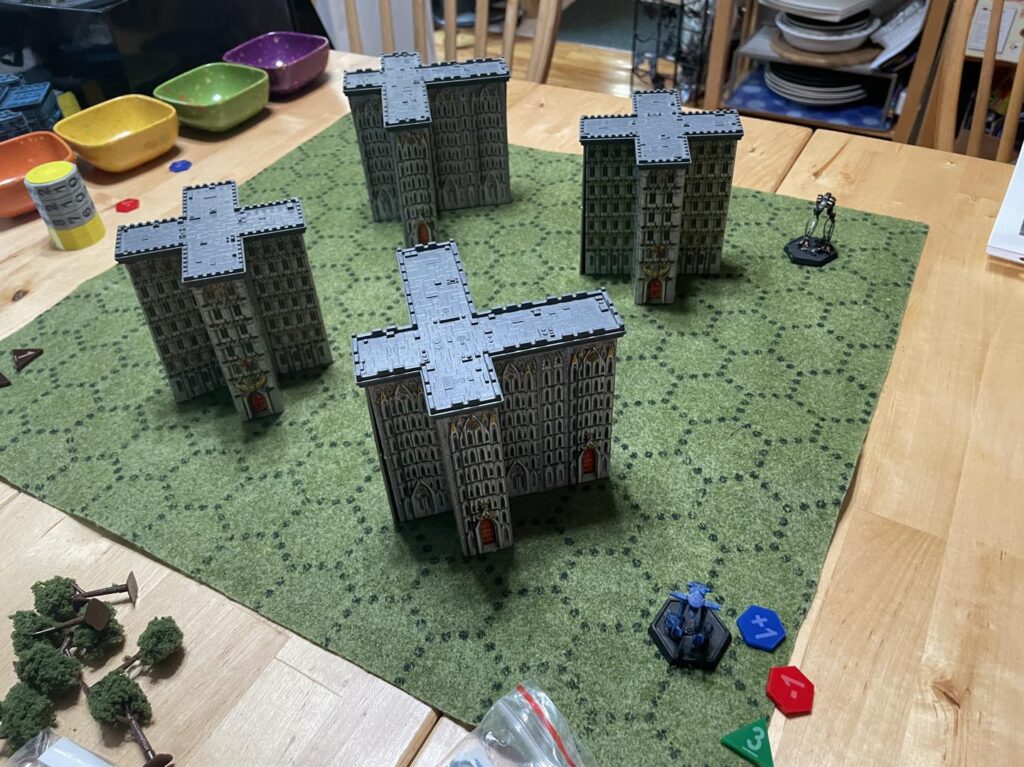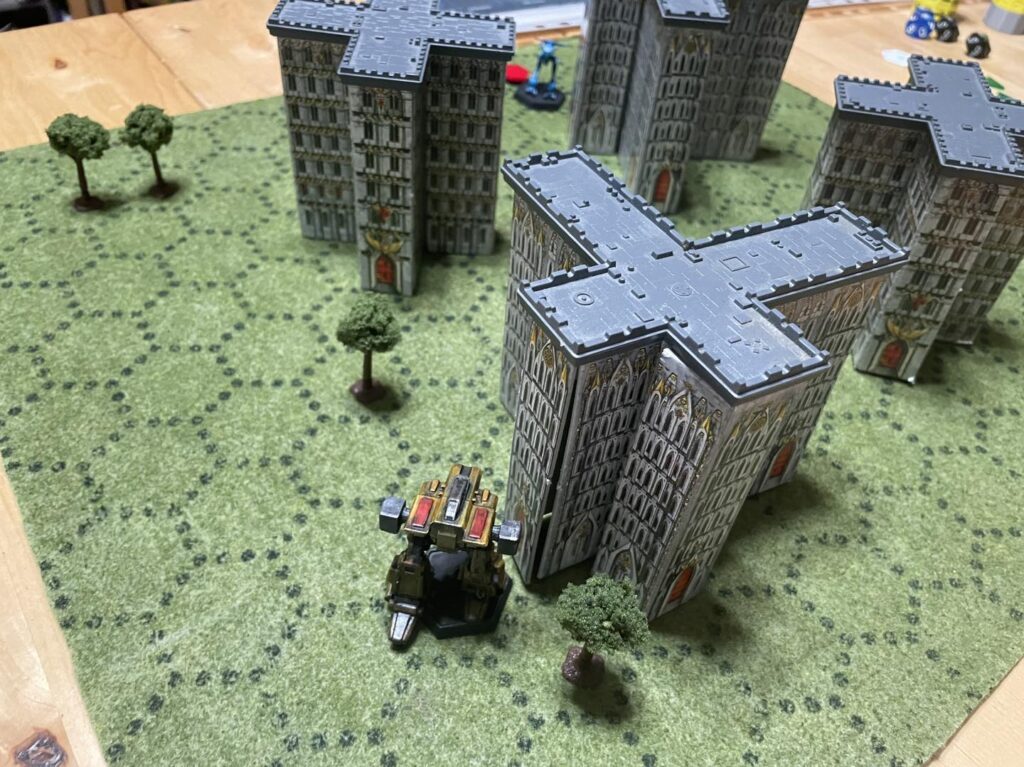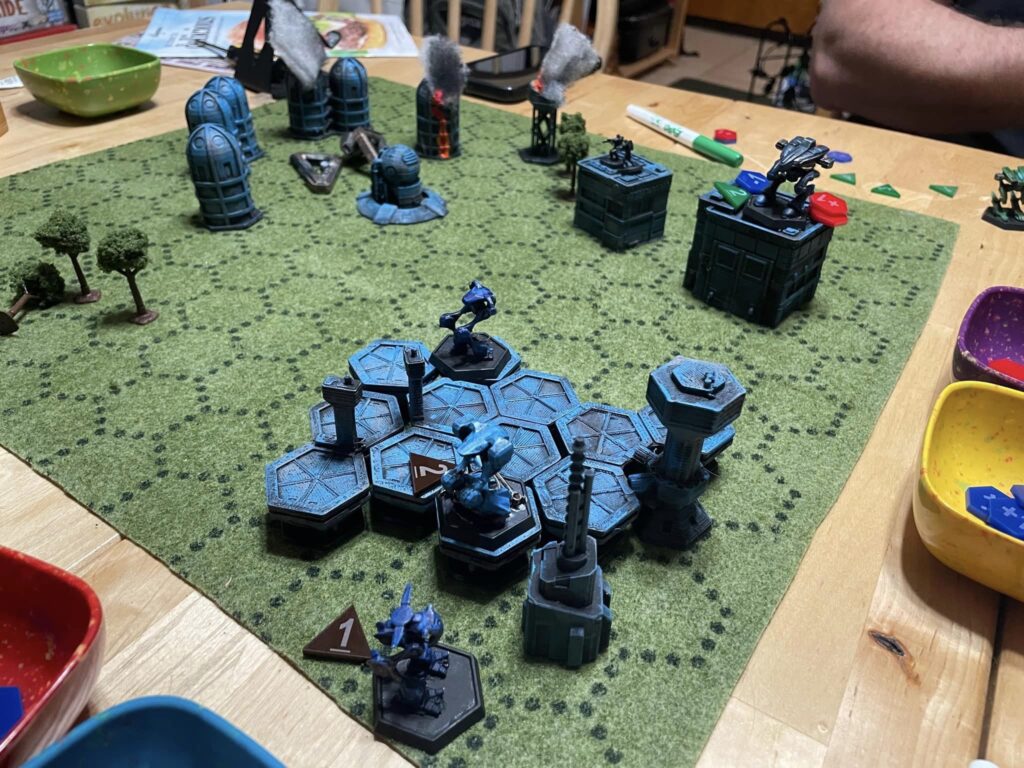First time here? Start with Dev Blog #1!
Want to help? Join us. We are still working on it!
Before I got all nostalgic about reuniting with my friend and thinking about days gone by, we had been planning to actually play the game.
We’ve had several in-person playtests and several virtual TTS playtests. Most of the games I have played have been on my dining table, frequently with one of my children, but I have been fortunate enough to have geeky friends, and they have consented now and then to play. That in-person feedback has been invaluable; seeing people react to the game, having those physical miniatures, and rolling physical dice all help tune the experience, with fewer distractions from technical support-related experiences that sometimes happen when doing a virtual game.
We have been tuning the rules, trying to increase the speed with which the game is played (new critical hit locations, extra damage, that sort of thing). We also recently created our starter scenarios, designed to introduce players to the rules in stages. Our combined arms units range from unmanned drones to manned mechs to small infantry power armor, and each unit type has special rules and play styles. Generally, the unmanned drones are the easiest to play, fast, few restrictions on movement, but more fragile than the other units, followed by the manned mechs, with their more ponderous movement restrictions but more powerful weapons, and lastly, the power armor, which requires the most nuance (I think) to play, since they are hard to hit, but have very few hit points and have special abilities that allow them to interact with the other units to sabotage the mechs, or hitch rides with them. We also added rules to limit the length of a game (optionally) to 6 full turns and a scoring mechanism to determine the victor in the event that one side was not completely destroyed.
We created three starter scenarios.
- Scenario 1: The drone mechs are small, fast, fragile, and the easiest to learn to play. They don’t worry about things like turning; they can face any direction and generally feel on the table like the original Lore game felt. This scenario recreates the original d20 playtest as well, so it’s a bit nostalgic.

- Scenario 2: This mission adds the manned mechs, which include things like linked, double attack weapons, slower speeds, paying movement points for changing directions, and force asymmetry and activations. It pits the largest manned mech against several smaller unmanned drones.

- Scenario 3: While we didn’t play this one during the test with my friend, this scenario is an objective-based mission and includes ALL of the unit types—a couple of large manned mechs, some infantry power armor, and drones. The drone force is trying to capture a salvaged core from a unit destroyed in a previous battle and escape. We have play-tested it a couple of times before, and it’s a pitched battle with lots of tactical nuance.

After playing the first two missions, I’d have to say this was probably the longest, most productive, and most FUN session I have ever had playtesting.
Lessons learned:
- Scenario 1: Feedback from an earlier virtual playtest indicated we might want to ease people into our notion of critical hits, and it’s been a growing consensus that those hits needed to be more punitive. We increased the damage those hits did and offered a simplified version of those rules as a special rule for Scenario 1. We tried that here, and it made the game faster. More damage!
- Scenario 2: I apparently created this based on old point values. I realized it almost immediately and gave the other guy an extra drone to compensate, but I didn’t actually pull out a calculator. Double-checking your work is my takeaway. Then, have someone else double-check it again. That said, we decided that with some more game experience, he still might have taken a victory with his inadequate force.
- While it is incredibly important to be an observer and watch how people play our game, it’s also crucial to play your game with people who play games and be a participant. I had fun, and that felt pretty damned good.
- This was the first playtest we had after a few weeks of downtime. Taking a break from working on a project let me return to it with a fresh perspective and participate more like a player than a designer, which was exhilarating. I wondered out loud why I changed a mechanic, which led to discussions about the mechanic with my buddy.
If you want to give it a go, head over to our discord and come say hello! We will get you set up! We are awfully close to being able to blind playtest this, but we’d love for you to stop by and hop into a guided playtest!